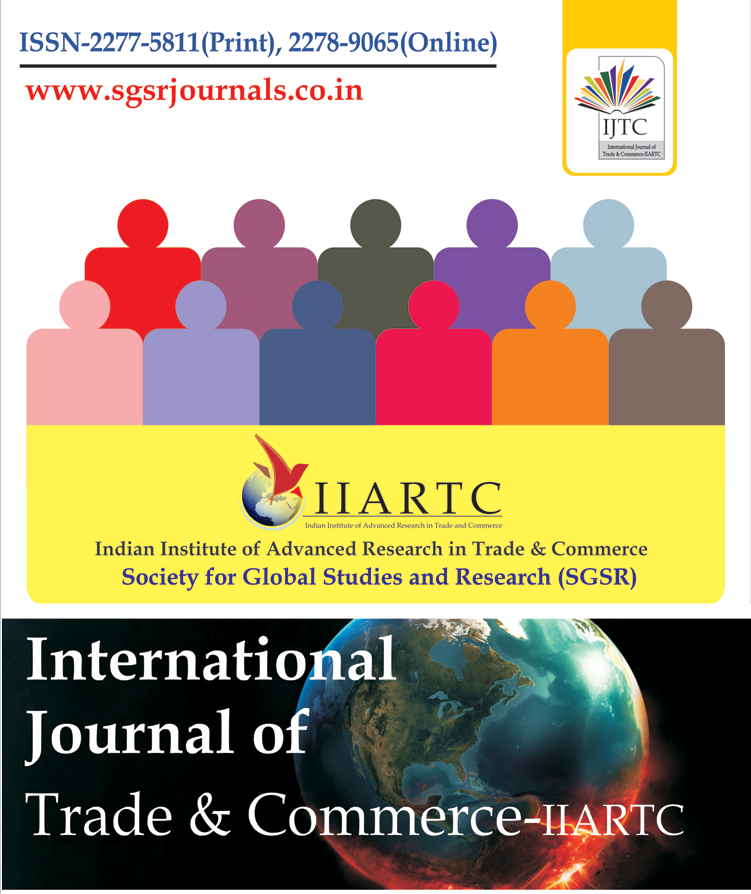Home ⇨ International Journal of Trade & Commerce-IIARTC

International Journal of Trade & Commerce-IIARTC
Impact Factor (IF):5.135 (COSMOS), IF:7.249 (ISRA), IF:3.721 (ISI)
ISSN:2277-5811 (P), ISSN:2278-9065 (O)
Frequency: Half Yearly
Demographic Dividend and Higher Education System in India : A Challenge and Opportunity
Youth can play a vital role in the formation of a country. The power of youth is believed to be one of the most important assets in the economic growth and prosperity of a country. This becomes even more significant when viewed in the context of a fast ageing population in the developed nations. By 2020 an average Indian expected to be only 29 years old against 37 years in China and U.S. 45 years in west Europe and 48 years in Japan. This is the Demographic dividend that we need to harness. The present higher education system in India is fragmented, scattered and takes place in more than 37,000 institutions called affiliated colleges many of which are tiny and trace better than higher secondary schools. 89% of under graduate students and 72% of post graduate students are enrolled in those colleges besides 83% of faculty members. Presently we are spending 3.8% of our GDP on education of which spending on higher education is 1.22% of GDP for the year 2010-2011. Individual monthly household expenditure on education is Rs.49.97 for the rural area and Rs.181.50 for urban area which constitutes 3.5% for rural and 7.5% for urban area of their total monthly expenditure. Tuition fee and private tutor accounts for their major portion of their spending on education while spending least on books, journals and library. By 2020 the working age population in India is expected to grow by 47 million. But size alone is not sufficient the quality of human resource is an important aspect. Indian youth needs to be equipped with knowledge and skills to compete globally. The primary ambition of young Indians are to move from smaller villages to large town to become rich but the gap between the youth expectation and reality is too wide. The present paper will focus on how we will bridge this gap and harness our youth to take advantage of this demographic dividend. The paper will also study whether our present higher education system and individual household expenditure on education is sufficient enough to meet this end?
Author:Preeti Rani*
Abstract:Youth can play a vital role in the formation of a country. The power of youth is believed to be one of the most important assets in the economic growth and prosperity of a country. This becomes even more significant when viewed in the context of a fast ageing population in the developed nations. By 2020 an average Indian expected to be only 29 years old against 37 years in China and U.S. 45 years in west Europe and 48 years in Japan. This is the Demographic dividend that we need to harness. The present higher education system in India is fragmented, scattered and takes place in more than 37,000 institutions called affiliated colleges many of which are tiny and trace better than higher secondary schools. 89% of under graduate students and 72% of post graduate students are enrolled in those colleges besides 83% of faculty members. Presently we are spending 3.8% of our GDP on education of which spending on higher education is 1.22% of GDP for the year 2010-2011. Individual monthly household expenditure on education is Rs.49.97 for the rural area and Rs.181.50 for urban area which constitutes 3.5% for rural and 7.5% for urban area of their total monthly expenditure. Tuition fee and private tutor accounts for their major portion of their spending on education while spending least on books, journals and library. By 2020 the working age population in India is expected to grow by 47 million. But size alone is not sufficient the quality of human resource is an important aspect. Indian youth needs to be equipped with knowledge and skills to compete globally. The primary ambition of young Indians are to move from smaller villages to large town to become rich but the gap between the youth expectation and reality is too wide. The present paper will focus on how we will bridge this gap and harness our youth to take advantage of this demographic dividend. The paper will also study whether our present higher education system and individual household expenditure on education is sufficient enough to meet this end?




